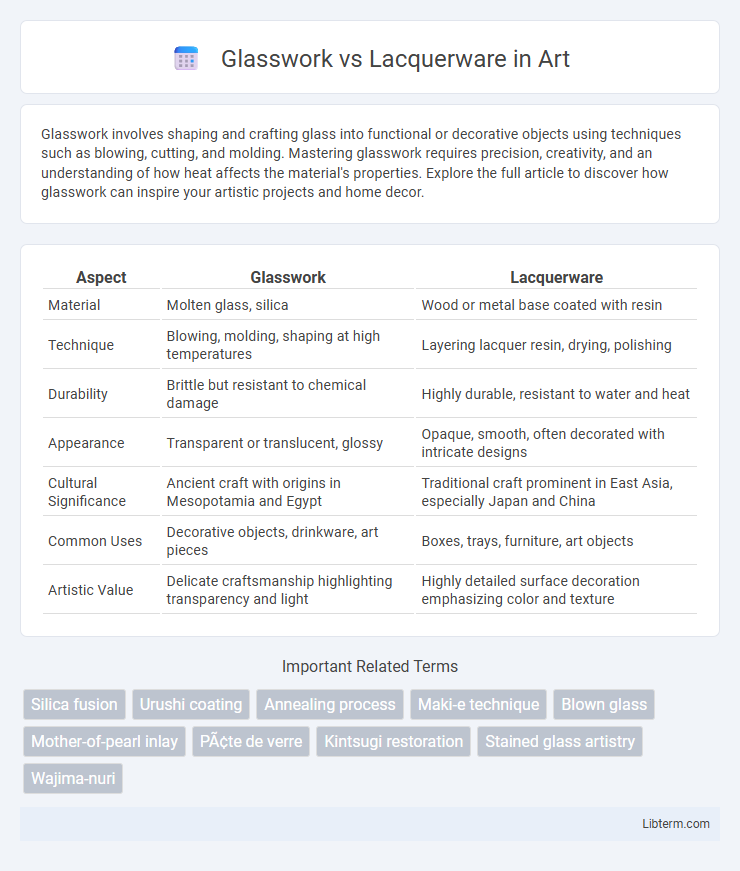Glasswork involves shaping and crafting glass into functional or decorative objects using techniques such as blowing, cutting, and molding. Mastering glasswork requires precision, creativity, and an understanding of how heat affects the material's properties. Explore the full article to discover how glasswork can inspire your artistic projects and home decor.
Table of Comparison
| Aspect | Glasswork | Lacquerware |
|---|---|---|
| Material | Molten glass, silica | Wood or metal base coated with resin |
| Technique | Blowing, molding, shaping at high temperatures | Layering lacquer resin, drying, polishing |
| Durability | Brittle but resistant to chemical damage | Highly durable, resistant to water and heat |
| Appearance | Transparent or translucent, glossy | Opaque, smooth, often decorated with intricate designs |
| Cultural Significance | Ancient craft with origins in Mesopotamia and Egypt | Traditional craft prominent in East Asia, especially Japan and China |
| Common Uses | Decorative objects, drinkware, art pieces | Boxes, trays, furniture, art objects |
| Artistic Value | Delicate craftsmanship highlighting transparency and light | Highly detailed surface decoration emphasizing color and texture |
Introduction to Glasswork and Lacquerware
Glasswork involves shaping and decorating molten glass into intricate objects using techniques such as blowing, molding, and engraving, celebrated for its translucency and elegant aesthetic. Lacquerware is the art of applying multiple layers of lacquer derived from the sap of lacquer trees onto wood, metal, or other materials, creating durable, glossy surfaces often embellished with intricate designs. Both crafts showcase exquisite cultural heritage and artistry, with glasswork emphasizing clarity and light manipulation, while lacquerware highlights surface durability and decorative appeal.
Historical Origins and Cultural Significance
Glasswork originated in ancient Mesopotamia around 3500 BCE, evolving through Roman innovations that popularized blown glass techniques, while lacquerware traces back over 3,000 years to East Asia, primarily China and Japan, where it became central to artistic and ceremonial traditions. Glasswork historically symbolized luxury and technological advancement in Western cultures, whereas lacquerware holds deep cultural significance in Asian societies, embodying craftsmanship and spiritual protection. Both art forms reflect their regions' cultural identities and historical trade routes, showcasing distinct aesthetic values and material technologies.
Key Materials and Techniques Used
Glasswork involves shaping and molding silica-based materials through heat, employing techniques like blowing, casting, and kiln-forming to create transparent or translucent objects. Lacquerware utilizes natural resin extracted from lacquer trees, applied in multiple layers over wood or metal surfaces, with polishing and inlay methods enhancing durability and intricate design. The distinct materials--molten glass versus resin-coated substrates--and their specialized techniques define the core differences between glasswork and lacquerware craftsmanship.
Design Aesthetics and Artistic Styles
Glasswork showcases transparency and light refraction, highlighting intricate patterns and fluid forms that emphasize clarity and brilliance. Lacquerware features rich, glossy surfaces with layered pigment applications, often adorned with traditional motifs, inlay, or carving techniques that convey cultural symbolism and depth. The design aesthetics of glasswork lean toward modern minimalism or delicate craftsmanship, while lacquerware embraces elaborate detailing and vibrant coloration unique to its artisanal heritage.
Durability and Longevity Comparison
Glasswork typically offers greater durability due to its resistance to scratches and chemical exposure, maintaining clarity and structural integrity over time. Lacquerware, while visually striking with its glossy finish, tends to be more susceptible to chipping, heat damage, and wear with prolonged use. Choosing between glasswork and lacquerware depends on the intended function, with glass providing longer-lasting resilience and lacquerware requiring careful handling to preserve its aesthetic appeal.
Functional and Decorative Uses
Glasswork offers both transparent and colored options highly valued for their ability to showcase contents and refract light, making them ideal for functional uses like drinkware and decorative items such as vases. Lacquerware, characterized by its durable, glossy finish achieved through multiple layers of lacquer, excels in ornamental bowls, trays, and boxes that resist moisture and wear. Both crafts enhance interior aesthetics, with glasswork emphasizing translucency and light interplay, while lacquerware focuses on rich colors and intricate designs for long-lasting beauty.
Environmental Impact and Sustainability
Glasswork involves melting silica and shaping it into durable, recyclable products that have a long lifecycle and lower environmental impact when recycled properly. Lacquerware uses natural tree resin, often harvested sustainably, but the production can involve toxic solvents and chemicals that pose environmental risks if not managed responsibly. Choosing glasswork over lacquerware generally supports better sustainability due to easier recyclability and less chemical use in manufacturing.
Price Points and Market Value
Glasswork typically commands higher price points due to the intricate craftsmanship and durability involved, making it a valuable investment in art markets. Lacquerware, while often more affordable, holds significant cultural value and appeals to collectors seeking traditional aesthetics with unique surface finishes. Market value for glasswork fluctuates with artist reputation and rarity, whereas lacquerware's value often depends on heritage, craftsmanship, and preservation quality.
Collectibility and Investment Potential
Glasswork often commands higher collectibility due to its intricate craftsmanship, historical significance, and the rarity of certain styles like Murano or Depression glass. Lacquerware's investment potential is driven by its cultural heritage, especially pieces from East Asia, with fine examples showcasing elaborate hand-painted designs and durable finishes that appreciate over time. Collectors seeking financial growth typically favor vintage glasswork for its market liquidity and established auction presence, while lacquerware appeals to niche collectors valuing artistic exclusivity and cultural authenticity.
Choosing Between Glasswork and Lacquerware
Choosing between glasswork and lacquerware depends on your preference for durability and aesthetic appeal; glasswork offers a sleek, transparent finish ideal for modern decor, while lacquerware provides a rich, glossy surface with intricate designs suited for traditional settings. Consider the intended use, as glasswork is more resistant to heat and scratches, whereas lacquerware requires careful handling to maintain its polished appearance. Budget and maintenance also play a role, with glasswork generally requiring less upkeep compared to the delicate nature of lacquerware finishes.
Glasswork Infographic

 libterm.com
libterm.com